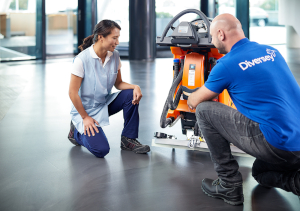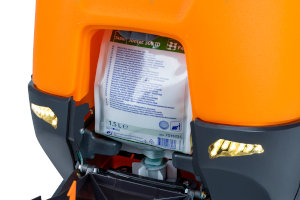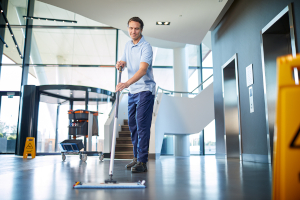Improving the sustainability of building care should look at every aspect of the operation. But with floorcare often representing a large, if not the largest, part of the daily routine this is where some of the simplest and biggest improvements can be made. Making changes that help to reduce consumption of chemicals, water, and energy can all contribute to saving costs and making processes easier as part of the wider sustainability objective.
The first thing to consider might not involve any changes at all. Making sure that you are using the right products and equipment will help to ensure that floorcare is efficient and consistent and delivers the best results. That will protect the floor, which is often an expensive asset, and delay or eliminate the need for any additional maintenance or – even worse – a replacement. Getting the right results first time every time will also avoid any need for repeat cleaning or supplementary or problem-solving tasks that can be time-consuming and expensive. That is all good for sustainability.
But even with the best floorcare operations there may still be room for improvement. Swapping to the same, or similar, product in a more concentrated format can offer benefits at many points from initial manufacture to the final disposal of empty containers. Another approach which can often be achieved at the same time is to introduce products with a more sustainable formulation. This might mean something that is gentler on the materials being cleaned or which is made from ingredients with less environmental impact, such as those which are based on by-products from existing processes.
The choice can depend on a number of factors, including sustainability. Many manufacturers offer formulations specifically developed to incorporate more sustainable - including plant-based and naturally occurring - ingredients. These will often carry environmental certifications such as EU Ecolabel, Nordic Swan, Cradle-to-Cradle, or the AISE Chartermark.
Swapping to an alternative formulation can often be achieved with little or no changes to existing processes or equipment. That can help to minimise, or even avoid, the need for additional training and other implementation costs. The choice of product will depend on the type of flooring material, the application, equipment being used, and the desired outcome. Manufacturers should be able to advise on the right ones from their ranges to meet desired cleaning and business objectives.
Modern scrubber driers are designed to optimise product use with minimum wastage. One way they do this is to prepare solutions as they are working using on-board dilution control systems similar to equipment used in other parts of building care. These solutions are accurate and consistent which ensures optimum results with no wastage. This is important because those that are too weak will give poor results and require a repeat clean, which will use more product, water, and energy as well as being time consuming. Those that are too strong, on the other hand, will also be wasteful and can leave residues on the floor that require additional rinsing and another pass of the machine in drying mode. Neither is efficient or sustainable.
Scrubber driers employ numerous techniques to reduce water consumption. Preparing solutions as they work avoids the need to prepare a full tank beforehand which might be poured away if not completely used. These machines also ensure the amount of solution delivered to the scrubbing mechanism is matched to the machine’s speed. In addition to saving water and product this makes it easier for the pickup mechanism to remove dirty solution from the floor with no need for a second pass of the machine. That saves time with the added benefit that the floor can be reopened for use far sooner than with older equipment.
All of these sustainability enhancements are relatively easy to make by choosing the right products and equipment and adopting similar – sometimes identical – processes. However, there are times when cleaning teams want an even more sustainable option. One way to do this is to clean without chemicals at all and for floorcare there are two very effective options. The first is to use reusable microfibre mops and cloths, ideally as part of an integrated and ergonomic cleaning system. Microfibre offers a number of benefits in floorcare (and surface cleaning in general), including that it can be used dry or with water alone to remove soiling and pathogens such as bacteria. With proper care, including laundry, these microfibre tools will offer consistent and reliable performance for hundreds of repeat uses to offer long term sustainability and total life cost savings.
Floorcare equipment such as scrubber driers and rotary disc machines can also be used with water alone when fitted with special pads that incorporate millions of microscopic diamonds. The diamonds gently scrub the surface and, depending on the size of their diamonds as designated by the pad colour, are used for tasks from deep cleaning and renovation through to final polishing. When the pads that are made from recycled plastics offering an extra dimension to their sustainability credentials.
Floorcare often represents a significant part of building care which means there is plenty of potential for sustainability enhancements. Maximising efficiency and productivity with simpler processes, adopting alternative products and equipment, and improvements to staff training can all help to reduce costs and consumption of products, water, and energy.
Suppliers should be able to demonstrate the sustainability benefits of their products and systems with modelling tools and calculators using real-world metrics and evidence. Those with proven products and track records can draw on their experience and expertise to work with in-house teams to ensure they meet their sustainability and business objectives.



